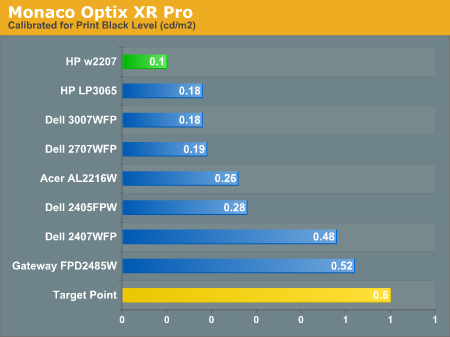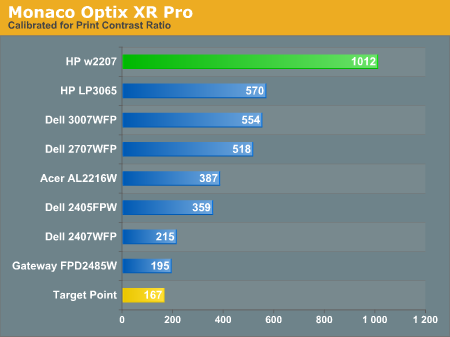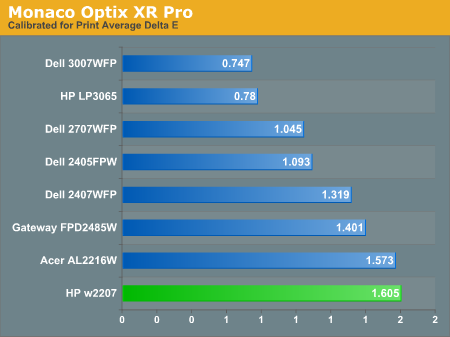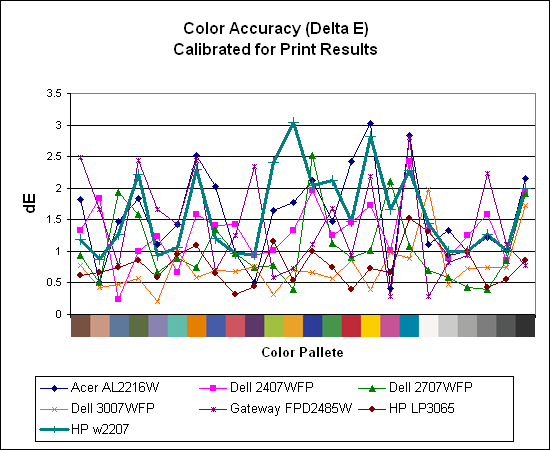Brightness and Contrast Ratio
For those who have a need to match colors between their computer displays, cameras, and printers, what works well for computing purposes often isn't the best suited for doing other image related work. To help people who work in such areas match their computer colors to their paper colors better, some standards were established. Generally speaking for print work the standard is a gamma of 2.2, a black point of 0.60 nits, and a white point of 100 nits. We attempted to calibrate all the monitors for these settings.
Finding the appropriate settings to reach these levels can be a time-consuming process for some of the displays. It may require numerous iterations through the calibration process to end up with the desired white point, and on some LCDs it might not even be possible to reach a satisfactory result (though that hasn't occurred yet). The nature of LCDs is such that we were unable to get both an accurate white point and an accurate black point according to printing requirements (our black levels always ended up darker than they are supposed to be), but we did manage to get near the desired 100 nits white point on all of the tested displays. For reference, we have included the target value in the following graphs, so the greater the deviance of a display from the targeted value, the less suitable (in theory) a display becomes for print work.



Since very slight differences in brightness are not a huge deal, we did not attempt to get 100% accuracy on the white point, but further tuning of the various displays would have made it possible to get closer to 100 nits. The primary goal was to get the white point near 100 nits. The target black point is nearly impossible to achieve once we have reached the target white point with any LCD that we have used. Due to the reduced brightness, contrast ratios are often lower, but that is expected with print material. The HP w2207 does maintain a very high contrast ratio of 1012:1 even at reduced intensities, which while not necessarily great for color matching with printers may be desirable for other users. Having calibrated the displays for printing, let's see how they actually fare.
Color Accuracy
Given the importance of accurate colors for printing work, the desired Delta E scale needs to be reevaluated. A Delta E of less than 1.0 is definitely the goal here, and 1.0 to 2.0 is merely acceptable. Scores above 2.0 basically mean that a display is not fit for printing professionals.


The two 30" displays clearly take the lead in this test, while both of the 22" displays rank at the bottom of the pack. It may be that the TN panels are to blame for the less than optimal results, but the conclusions are pretty clear. If the intended goal is to get all of the scores below 2.0 Delta E, only the 30" LCDs manage this. The HP w2207 ends up with a fully one third of the test colors falling into the 2.0 or higher Delta E range.
For those who have a need to match colors between their computer displays, cameras, and printers, what works well for computing purposes often isn't the best suited for doing other image related work. To help people who work in such areas match their computer colors to their paper colors better, some standards were established. Generally speaking for print work the standard is a gamma of 2.2, a black point of 0.60 nits, and a white point of 100 nits. We attempted to calibrate all the monitors for these settings.
Finding the appropriate settings to reach these levels can be a time-consuming process for some of the displays. It may require numerous iterations through the calibration process to end up with the desired white point, and on some LCDs it might not even be possible to reach a satisfactory result (though that hasn't occurred yet). The nature of LCDs is such that we were unable to get both an accurate white point and an accurate black point according to printing requirements (our black levels always ended up darker than they are supposed to be), but we did manage to get near the desired 100 nits white point on all of the tested displays. For reference, we have included the target value in the following graphs, so the greater the deviance of a display from the targeted value, the less suitable (in theory) a display becomes for print work.



Since very slight differences in brightness are not a huge deal, we did not attempt to get 100% accuracy on the white point, but further tuning of the various displays would have made it possible to get closer to 100 nits. The primary goal was to get the white point near 100 nits. The target black point is nearly impossible to achieve once we have reached the target white point with any LCD that we have used. Due to the reduced brightness, contrast ratios are often lower, but that is expected with print material. The HP w2207 does maintain a very high contrast ratio of 1012:1 even at reduced intensities, which while not necessarily great for color matching with printers may be desirable for other users. Having calibrated the displays for printing, let's see how they actually fare.
Color Accuracy
Given the importance of accurate colors for printing work, the desired Delta E scale needs to be reevaluated. A Delta E of less than 1.0 is definitely the goal here, and 1.0 to 2.0 is merely acceptable. Scores above 2.0 basically mean that a display is not fit for printing professionals.


The two 30" displays clearly take the lead in this test, while both of the 22" displays rank at the bottom of the pack. It may be that the TN panels are to blame for the less than optimal results, but the conclusions are pretty clear. If the intended goal is to get all of the scores below 2.0 Delta E, only the 30" LCDs manage this. The HP w2207 ends up with a fully one third of the test colors falling into the 2.0 or higher Delta E range.










43 Comments
View All Comments
Bjoern77 - Thursday, August 2, 2007 - link
You'll find that Monitor to be very popular in Europe, specially Germany due to it's low price.Well - low price compared to other monitors.
EG, the Dell 2407 WFP HC is supposed to cost around 1000$ here, the older version is on "sale" for about 850$. If i see the US-Prices for tfts...ouch. Same goes for a lot of other monitors. The HP is the first i noticed on the us markt which seem to be on a European price level, which, i assume, is at least 25% higher.
trajan - Wednesday, August 1, 2007 - link
The one thing I immediately noticed from the review was the difference between the Gateway 24" and the Dell 24". I've never seen these ratings before -- it looks like in most catagories the Gateway is superior. Am I reading this right? I thought the Dell was the hands down 24" champion!JarredWalton - Wednesday, August 1, 2007 - link
The Gateway has a brighter backlight, but in most other areas I felt the 2407WFP and the FPD2485W were about the same. I prefer the appearance of the Dell LCD over the Gateway LCD, and the extremely bright backlight on the Gateway means that you usually have to spend more time tuning things if you don't want to be blinded. If you had them both set to the same intensity, however, I don't think most people would be able to tell the difference between the panels.nilepez - Wednesday, August 1, 2007 - link
I'm still using an old CRT, and I don't know why one would compare at a monitor with a max resolution of 1600x1050 to a CRT that was likely capable at least 1800x1440 and 1920x1440 was fairly common. Mine goes higher, but the refresh rate is too slow at that point.I personally think that the 24" displays are the first ones that are comparable to 21" monitors. The 22" monitors are more comparable to some of the better 19" monitors (though I suppose there may have been crappy 21" monitors with a max usable res of 16x12.
I personally wish I could justify the 30" monitors, but at current prices, I'd be better off going dual monitor with 2 24" models (desktop space is king :) )
Jodiuh - Wednesday, August 1, 2007 - link
Have you seen a nice 20in S-IPS next to your old CRT? I have an older 19in CRT and it pales in comparison to the NEC or Dell panels.yyrkoon - Thursday, August 2, 2007 - link
I had a professional grade 21" CRT next to my 19" WS LCD, and I have to say that the LCD is much, MUCH better for vibrance/image sharpness. The LCD to boot was also 1/5th-1/6th the cost of the 21" CRT . . .nilepez - Wednesday, August 1, 2007 - link
Probably not, given that most stores carry crappy monitors, but I'm really not willing give up real estate to move to a flat screen.even at 1920x1440, I feel cramped if I'm I've got more than 2 instances of jedit open (and I'd really like to have 4, and occasionally more, in most cases).
24" monitors are the smallest monitors with sufficient resolution, although even then, my desktop shrink by almost 20%.
Great Googly Moogly - Thursday, August 2, 2007 - link
Well, it seems you're forgetting about pixel pitch. Those 1920x1200 24" have quite a high pixel pitch. Certainly a 20.1" LCD with a 1600x1200 resolution is better for you?The only LCDs with a decent pixel pitch not stuck in 1991 (seriously) are the 1280x1024 17" (too small, physically, though), 1600x1200 20.1" and the 2560x1600 30".
The new 1920x1200 26-27" are really atrocious, and the most popular 1680x1050 22" is not up to my standards either--hence the main reason (out of many) why I'm still on an iiyama CRT. And if this trend is still going in a few years, we'll have 720p 40" computer monitors. And everyone will love them.
So sick and tired of computer display tech going steady backwards since the 90s.
jc44 - Thursday, August 2, 2007 - link
To be fair 2001 was a good year for displays - IBM built the first T221s (24" 3840x2400) :-) 2006 was not such a good year - IBM ceased production of T221s with nothing even vaguely equivalent in sight from anybody :-(strikeback03 - Thursday, August 2, 2007 - link
Didn't they cost somewhere around $30,000? no wonder they disappeared.